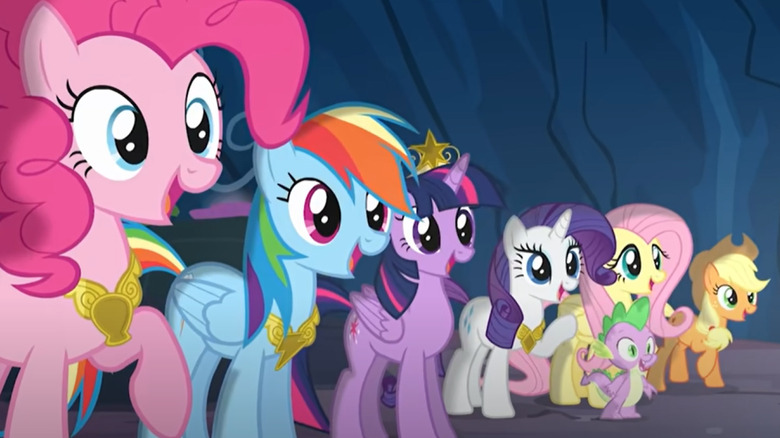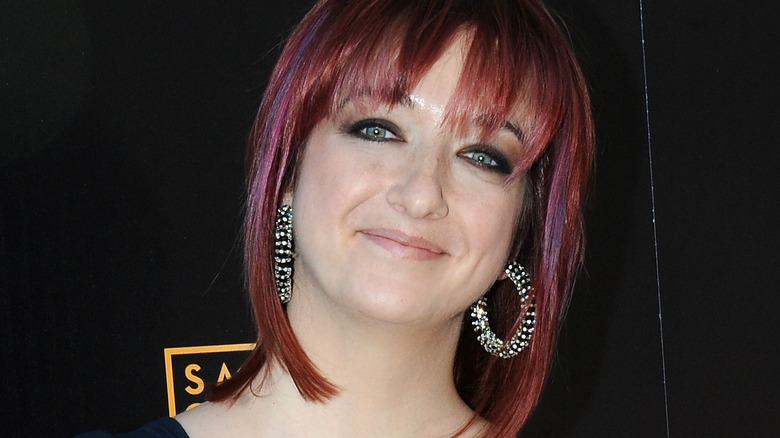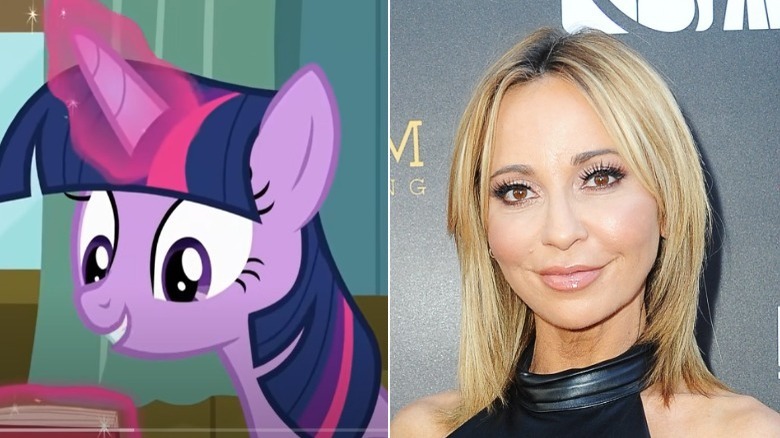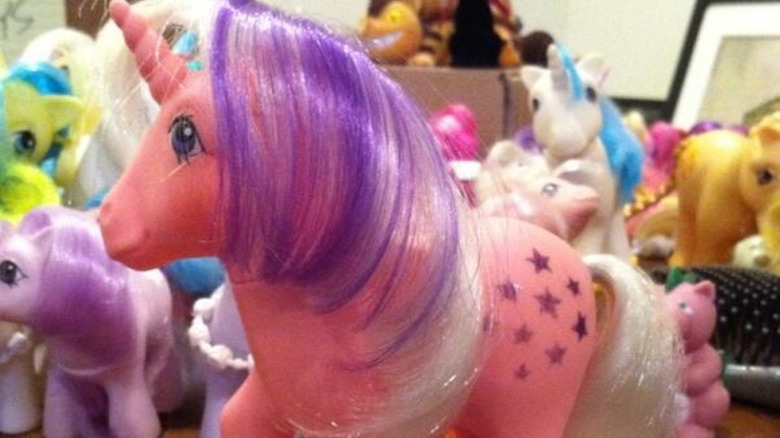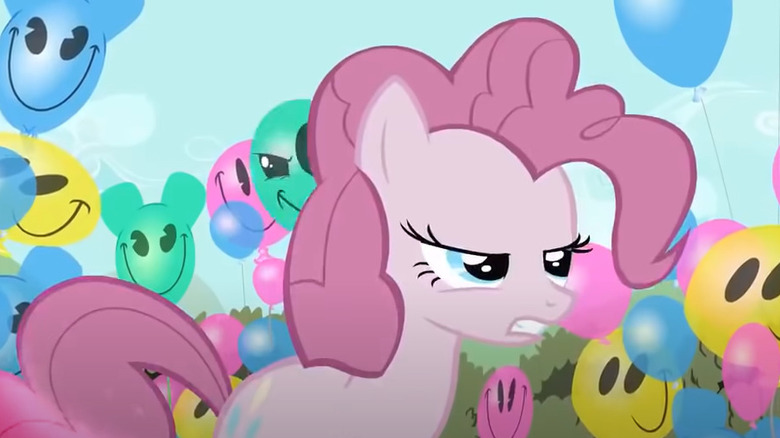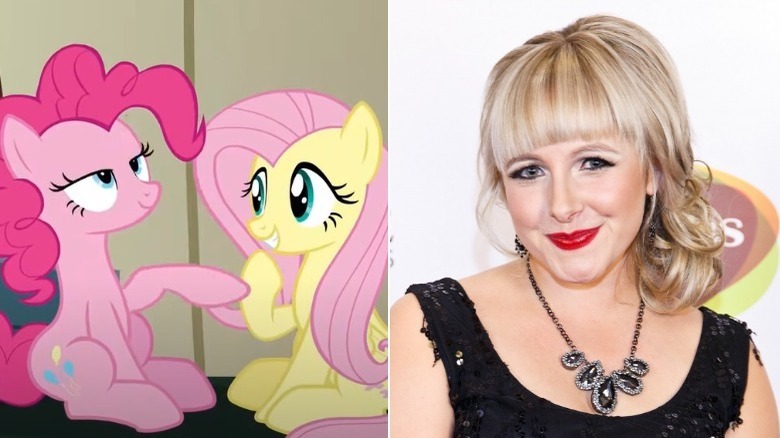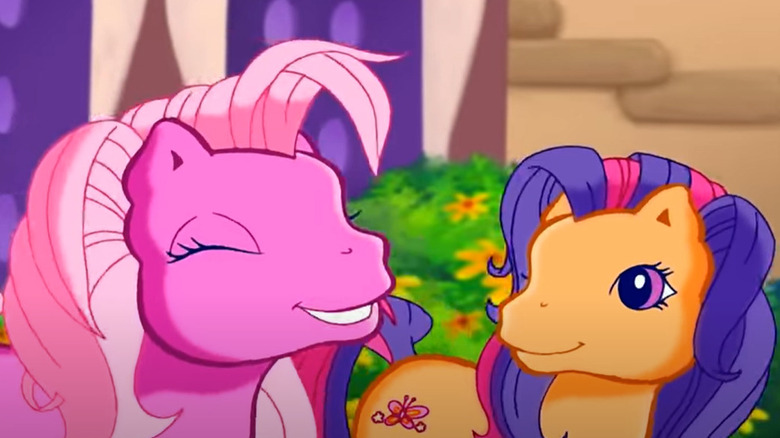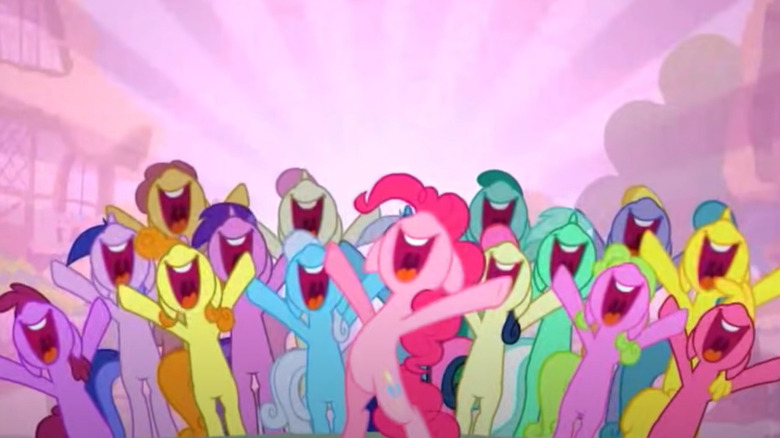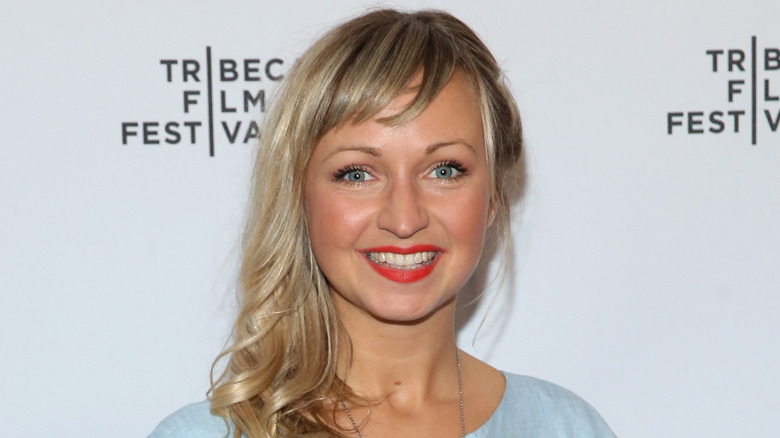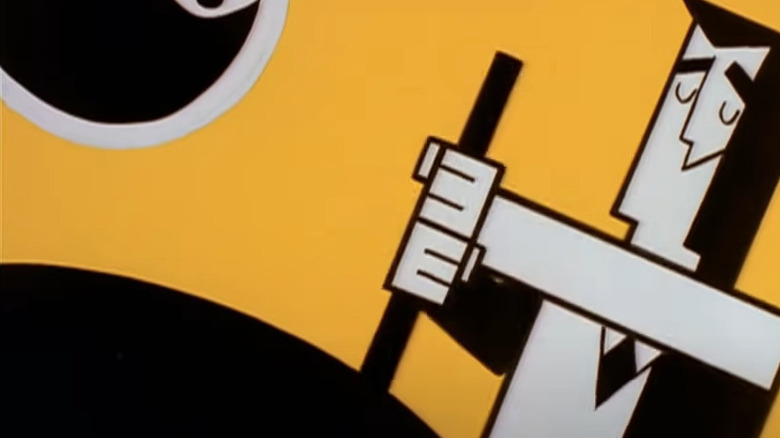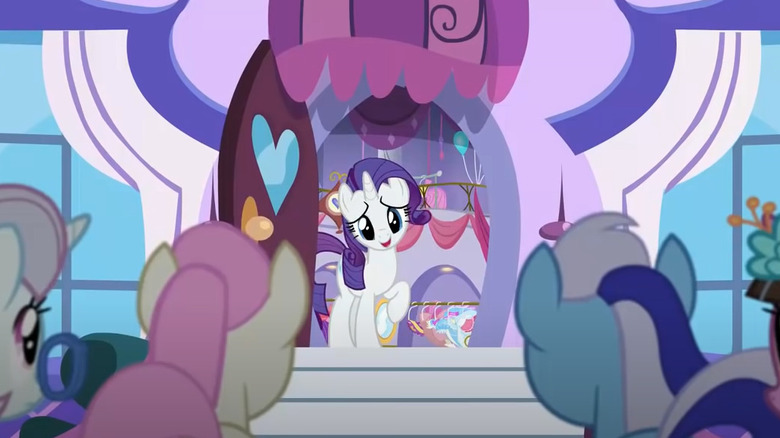The Truth About My Little Pony's Mane 6
"My Little Pony: Friendship is Magic" reignited a national craze for the whimsical franchise helmed by the toy company, Hasbro, when it premiered in 2010. The show features the first appearance of the Mane Six characters: Rainbow Dash, Twilight Sparkle, Apple Jack, Pinkie Pie, Rarity, and Fluttershy. The series' first season holds the prestigious "Certified Fresh" score on Rotten Tomatoes with a score of 100%. By this measure, Season 1 of "Friendship is Magic" holds the same score as the shows "Breaking Bad," "Fleabag," and "Bojack Horseman" (via Rotten Tomatoes).
"Friendship is Magic" is a true passion project for creator Lauren Faust, who grew up playing with the earliest generations of ponies. Faust's childhood connection with the ponies was explored in Season 3, Episode 3 of "The Toys That Made Us," where she described how she would attribute unique personality traits to the ponies based on their "butt symbols," as she used to call them.
Faust's love for the series is evident in its execution. Originally marketed as a show for young girls, the show quickly gained a massive adult following – leading adults to notice things in the new series that younger kids wouldn't – including a particularly unexpected fanbase. "Bronies," or adult male fans of the show, quickly demonstrated how the show transcended gender role stereotypes and what quality television looked like.
Luckily for trivia and pony fanatics, we've got several little-known facts about the production of "Friendship is Magic." Here's the truth about the Mane Six!
The Mane Six were designed to break stereotypes
Lauren Faust, creator of "My Little Pony: Friendship is Magic," had years of experience crafting adventure stories for magical ponies: She even attributed her own toys' adventures for being the foundation of her creativity and storytelling abilities. "I think I made up stories right out of the gate, when I got my first pony toys," Faust said in "Bronies: The Extremely Unexpected Fans of My Little Pony."
With the franchise near and dear to her heart, Faust set out to create a series that accurately captured the spirit of the toys in a way that honored the original target audience for the product. "I'm proud that I could make a show for girls that was something that was legitimately entertaining to watch," she said in an interview with Discovery Family. Faust explained how she felt that shows marketed to young girls often made fun of them and reinforced harmful stereotypes. "In short, animated shows for little girls come across as boring. Stupid. Lame," she wrote in a personal essay for Ms. Magazine.
Faust told Equestria Daily that the Mane Six were specifically designed to break some of those two-dimensional stereotypes in storytelling. For example, Twilight Sparkle is smart and sweet, and Rarity is beautiful but not a mean girl. Rarity, who is the show's fashion-obsessed character, is "not a shopaholic. She's an artist!" Faust said. In fact, she wrote, via Ms. Magazine, "There are lots of different ways to be a girl."
You've definitely heard Twilight Sparkle's voice before
Twilight Sparkle is arguably the main Mane Six character in "My Little Pony: Friendship is Magic." The show begins with Twilight recognizing that friendship is an important part of life and follows her character's growth and development as she trains under Princess Celestia. So it makes sense that one of the most popular voice actors was cast as the show's lead.
Tara Strong has been credited with over 600 voice acting roles on IMDb. If you've ever watched a cartoon, there's a strong possibility you've heard a character voiced by Strong. Some of her most notable animated roles include Timmy Turner in "Fairly OddParents," Harley Quinn and Batgirl in the DC animated franchise, Raven in "Teen Titans," Dil Pickles in "Rugrats," Miss Minutes in "Loki," and Bubbles in "The Powerpuff Girls" (via IMDb).
Strong also worked with "Friendship is Magic" creator Lauren Faust on "The Powerpuff Girls," a show created by Craig McCracken. The trio became incredibly close from their time working together, and Faust approached Strong while working on the original pitch for "Friendship is Magic." Strong told The A.V. Club that when she helped Faust develop the pitch, "she was like, 'I knew you were my Twi the second I heard you do it.'"
Twilight Sparkle's design changed many times
The purple and pink Twilight Sparkle that we know and love actually used to look a lot different. Lauren Faust tweeted a photo of her original Generation 1 Twilight pony with the caption "Twilight became Twilight," which she elaborated on in an episode of "The Toys That Made Us." Faust said she had used her own childhood toy to inspire her design for Twilight Sparkle in "My Little Pony: Friendship is Magic."
The toy in question, however, looks a lot different than Twilight's final design. The Generation 1 pony is coral pink with white hair that has a purple stripe running through it, whereas Twilight Sparkle is light purple with dark blue hair that features a pink stripe — just one small detail you may have easily missed in the new generation.
The missing link between Faust's childhood toy and Twilight Sparkle's final design was revealed on Twitter as part of Faust's #MLPtrivia series. Early designs of the character apparently depicted her with dark blue hair featuring a light blue stripe of hair. Not only did her coloration undergo some significant changes, Twilight Sparkle was also originally named Twilight Twinkle, as revealed by M.A. Larson, a writer for the show (via "Radio is Magic").
Pinkie Pie was originally a lot less pink
According to Lauren Faust, "My Little Pony: Friendship is Magic" creator, the character of Pinkie Pie was based on a pony that wasn't even pink. In an episode of "The Toys That Made Us," Faust revealed she had based the character on a white Pegasus pony from her childhood named Surprise. Faust described the personality she attributed to Surprise as "the perky excited one." The pony in question has a white Pegasus body with electric yellow hair — vastly different from the all-pink Pinkie Pie.
The eventual color and design for Pinkie Pie appears to have originated from the Generation 3 pony of the same name, which features a pink body with pastel pink hair and even the same cutie mark as the "Friendship is Magic" Pinkie: three multicolored balloons.
The irony of Pinkie's origins and subsequent design was not lost on Faust. In her #MLPtrivia series on Twitter, Faust posted a photo of her original white Pegasus pony with the caption: "SURPRISE!!! A Pegasus inspired Pinkie Pie."
Pinkie Pie and Fluttershy are voiced by the same person
Pinkie Pie and Fluttershy are nearly each other's polar opposites: Pinkie is loud, energetic, and bold, while Fluttershy is quiet, gentle, and soft-spoken. Despite their differences, however, the two characters share a lot in common, including a voice actor. Andrea Libman is the voice behind both Pinkie Pie and Fluttershy, which often creates interesting recording sessions when the two characters converse with one another. "It gets easier and easier to switch back and forth," Libman told EQI, explaining how her strong grip of the characters helped her make the quick transitions between Pinkie and Fluttershy. "I just feel crazy when I'm doing it," she said.
Libman gets a break from the transitions during musical numbers, though. Shannon Chan-Kent is behind the singing voice for Pinkie Pie in a role she landed when she helped a songwriter for the series prepare a demo for "The Laughter Song" (via Everfree Network). Chan-Kent is no stranger to animated series based on toy franchises for young girls either: The actress has credits in "Strawberry Shortcake," "Polly Pocket," and "Littlest Pet Shop," to name a few (via IMDb).
The Friendship is Magic voice actors have voiced ponies in other shows
"Friendship is Magic" isn't Andrea Libman and Tabitha St. Germain's first rodeo apparently. "In My Little Pony: Meet the Ponies," Libman provided the voice for the Generation 3 pony named Sweetie Bell (via Everfree Network). Through her experience on "Meet the Ponies," Libman was called into an audition for "My Little Pony: Friendship is Magic" when the show began casting.
St. Germain had an extensive history with the franchise's animated series. She told Everfree Network that by the time she had been called into the audition for "Friendship is Magic," "I'd been in, I think, maybe four generations of it already beforehand." St. Germain voiced characters Minty, Wysteria, Scootaloo, and Thistle Whistle amongst several other minor roles (via IMDb). "I loved playing Minty," she said in her interview.
While "Friendship is Magic" was the gateway to Ponyville for Tara Strong and Ashleigh Ball, the two became involved in somewhat related projects later on. Strong became an executive producer for the documentary movie "Bronies: The Extremely Unexpected Adult Fans of My Little Pony," which explores the brony phenomenon, its implications on social expectations of masculinity, and its subsequent online communities (via IMDb). Ball similarly produced the 2014 documentary "A Brony Tale," which follows her preparations and visit to Bronycon, the annual convention for bronies.
The Mane Six are all voiced by Canadian voice actors
All of the Mane Six have Canadian voice actors. Tara Strong, Ashleigh Ball, Andrea Libman, and Tabitha St. Germain originally hail from Canada, with both Strong and Libman coming from Toronto, while Ball and St. Germain hail from Vancouver (via IMDb).
Even the voice actors behind the ponies' singing voices have Canadian origins. Rebecca Shoichet, Kazumi Evans, and Shannon Chan-Kent, who sing for Twilight Sparkle, Rarity, and Pinkie Pie, respectively, were also born and raised in Canada (per IMDb).
The overwhelming majority of Canadian talent involved in the show can be best explained by its production location: Vancouver, Canada (via the Toronto Star). DHX Media is the Vancouver-based production company behind Hasbro's hit television series, and "My Little Pony: Friendship is Magic" producer Devon Cody told CBC News that nearly 70 different artists from DHX contribute to each episode and that just about every artist is Canadian-based. Cody saw the success of "Friendship is Magic" as a major stepping stone for the company and Canadian animation talent as a whole. "We have the chops here creatively to take a big brand with a lot of pressure, execute on that reputation and legacy, do it well and bring it to another level," he told CBC after the show concluded its nine-season run.
Ashleigh Ball originally auditioned for Spike the Dragon
The voice behind two of the Mane Six didn't audition for either of them at first. Ashleigh Ball, who voices both Rainbow Dash and Applejack, told Everfree Radio that she originally auditioned for the role of Spike the Dragon and even got a callback for the role. When Ball learned she had landed the roles for both Rainbow Dash and Applejack, she was excited but also a bit disappointed she wouldn't be voicing the little dragon. The role instead went to Cathy Weseluck, who's best known for voicing the English dub of Near in "Death Note," as well as many other credits in children's cartoons and anime series (via IMDb).
Ball described her audition voice for Spike as "raspy," like Rainbow Dash's. While her voice for Rainbow Dash is definitely put-on, she told Everfree Radio that the voice "is pretty close to my own, actually." Applejack's voice evolved with the first series of the show and is noticeably higher in early episodes. To better differentiate the two voices, Applejack's voice eventually got deeper until it was at a level that Ball could comfortably perform. Differentiation between the voices was important for Ball, since she told Everfree Radio she would "usually just switch in between" the voices while the characters were conversing with one another, rather than recording each separately.
The Wonderbolts were designed by the creator of The Powerpuff Girls
The Wonderbolts make up the aerial acrobatic team of pegasi that Rainbow Dash eventually joins. And, no, the Wonderbolts were not designed by Professor Utonium but rather by animator Craig McCracken, who created "The Powerpuff Girls" series as well as "Foster's Home for Imaginary Friends" and "Wander Over Yonder" (via IMDb). This trivia fact was revealed by Lauren Faust via her #MLPtrivia series on Twitter. Another fun fact? Faust and McCracken are married in real life — talk about a power couple!
Many fans have speculated that the design of the Wonderbolts is based off of The Blue Angels, which make up the Navy's aerobic jet team. The Blue Angels share a very similar color palette as the Wonderbolts: Both the Angels and Wonderbolts use a navy blue and gold color scheme, with past Wonderbolt uniforms resembling historic Air Force and military uniforms.
Rarity's shop had a much different original design
By creator Lauren Faust's own admission, the show needed fashion play as per a studio request. "My Little Pony" was owned by a toy company after all, and to keep executives happy while maintaining a break from fashionista stereotypes, Faust specifically designed Rarity as a businesswoman (or business pony, if you will.) Faust wrote in Ms. Magazine of Rarity: "She is not a trend follower but a designer who sells her own creations from her own store." Thus, Rarity was given Carousel Boutique, a studio space and business space for Rarity to design and sell her creations.
According to Faust, the original design for Carousel Boutique was a working carousel (via Twitter). This first draft of Rarity's shop was called Carousel Couture, and it moved as a carousel would normally move, with the carousel horses serving as clothing mannequins. Unfortunately, Carousel Couture never came to see the light. Executives rejected Faust's design, as she shared with her followers on Twitter in a thread for her #MLPtrivia.
This design rejection was just one of many creative restrictions that caused Faust to eventually leave the series in Season 2. "Various circumstances with the production made it increasingly impossible for me to keep up the level of personal creative involvement and control that I had at the start of the series," she wrote on her Deviant Art page when announcing her departure. At least Faust was able to remain true to her artistic intent.
